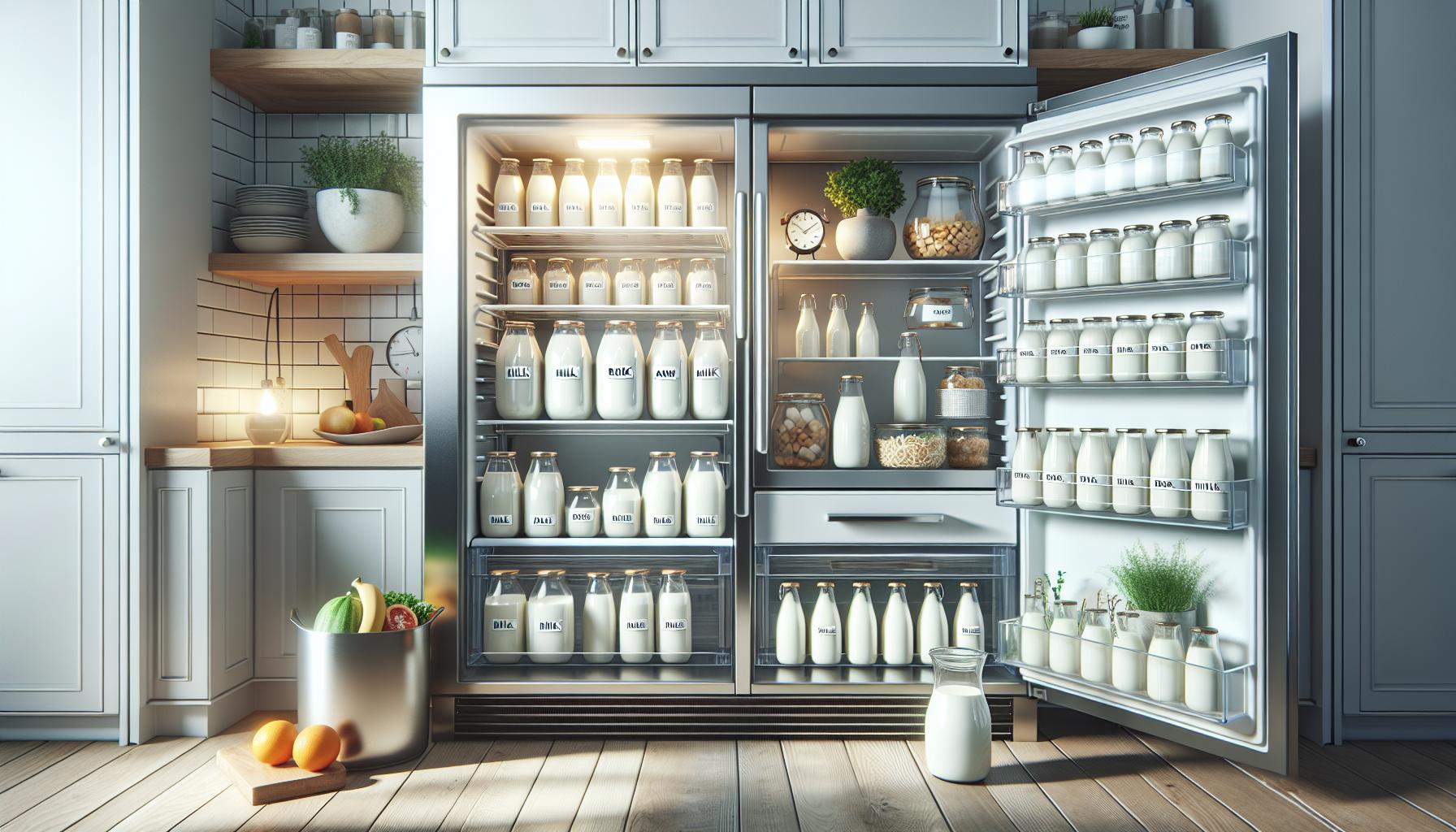Raw milk is a delicious and nutritious alternative to pasteurized options, but how long can you trust its freshness in your fridge? Understanding the shelf life of raw milk is crucial for both taste and safety, as improper storage can lead to spoilage and potential health risks.
Many consumers are curious about the duration raw milk remains safe and enjoyable to drink. Factors such as storage temperature and packaging can significantly affect its longevity. Knowing the right practices ensures you can make the most of your purchase while minimizing waste.
In this article, we’ll explore the intricacies of raw milk storage, providing you with science-based insights and practical tips to ensure you always have fresh, safe milk on hand. By the end, you’ll feel confident in managing your raw milk, preserving its creamy goodness as long as possible. Read on to discover how to keep your raw milk fresh and delicious!
How Long Does Raw Milk Last in the Fridge?
Raw milk typically remains fresh for about 7 to 14 days when stored properly in the refrigerator at or below 40°F (4°C). However, the exact duration can vary depending on several factors including the initial quality of the milk, how it was handled post-collection, and the conditions in which it is stored. One captivating aspect of raw milk is that, unlike pasteurized milk, its freshness is significantly influenced by how quickly it is cooled after milking and how well it is kept consistently cold.
To maximize the shelf life of raw milk, always keep it in the coldest part of your fridge, ideally nearer the back rather than the door, where temperatures can fluctuate. It’s also a good practice to seal it tightly in its original container or transfer it to a glass or food-safe container that minimizes air exposure. Regularly checking the smell and taste of the milk can help assess its freshness. If it develops a sour smell or a different flavor, it should be discarded.
Understanding the storage conditions and microbial growth is essential; raw milk is alive and contains bacteria that can continue to grow throughout its storage life. Proper management of these factors not only ensures health safety but allows you to enjoy the raw milk’s unique flavor and benefits during its optimal freshness period. When in doubt, relying on sensory indicators like aroma and flavor can be a good rule of thumb to gauge freshness.
Understanding Raw Milk Freshness Levels
Raw milk is a living food that can retain its freshness for a surprisingly short window, typically between 7 to 14 days when stored at optimal temperatures. The perception of freshness in raw milk is not solely about the passage of time; several critical factors can significantly impact its shelf life. For instance, the initial health and hygiene practices of the dairy from which the milk is sourced are paramount. Milk harvested from healthy cows in a clean environment tends to last longer than milk from less stringent conditions. Furthermore, how quickly the milk is chilled after collection plays a crucial role; rapid cooling can help preserve its quality and prolong its shelf life.
To ensure that raw milk remains fresh for as long as possible, proper storage techniques are essential. Store it in the coldest part of your refrigerator, ideally at the back, where temperatures remain consistent and are less affected by frequent door openings. Additionally, keeping raw milk in its original container is advisable, as it is designed to minimize exposure to air and light, both of which can accelerate spoilage. If you decide to transfer the milk to a different container, choose glass or food-safe plastics that seal tightly.
Regular sensory checks should also be part of your routine. Fresh raw milk should have a mild, pleasant aroma and taste. If you notice any sourness or off flavors, it’s an immediate sign that the milk is no longer fresh and should be discarded. Understanding these freshness levels empowers you to make informed choices about the milk you consume, ensuring that you enjoy its full flavor and health benefits while adhering to safety protocols. Always remember that while raw milk can deliver unique flavors and nutritional benefits, its freshness is fundamentally linked to how it is handled from farm to fridge.
Factors Influencing Raw Milk Shelf Life
The shelf life of raw milk is influenced by several critical factors that go beyond just the date on the label. For one, the health and cleanliness of the dairy farm where the milk is sourced plays a crucial role. Milk collected from healthy cows in a clean, sterile environment is likely to retain its freshness longer than milk from cows in suboptimal conditions. Hygiene practices during milk harvesting and bottling can significantly affect microbial load, which directly impacts spoilage rates.
Another vital element is the cooling process immediately post-harvest. Rapid chilling of raw milk slows down bacterial growth and enzymatic activity, preserving quality and extending shelf life. Ideally, raw milk should be cooled to below 40°F (4°C) within two hours of milking. If this step is neglected, even fresh milk can spoil within a few days, leading to food waste and potential health risks.
Storage conditions also affect how long raw milk remains fresh. Keeping the milk in the coldest part of the refrigerator-typically at the back-helps maintain a consistent temperature that deters bacterial growth. Furthermore, using the original container or a well-sealed glass or food-safe plastic container minimizes exposure to air and light, both of which can accelerate spoilage. Regularly monitoring the milk’s smell and taste can provide early indications of freshness; if it starts to sour or develop off flavors, it should be discarded immediately, regardless of any labels.
Additionally, the time of year can influence milk shelf life; warmer temperatures can expedite spoilage. Consumers should be aware of their local climate and the impact it might have on the freshness of their raw milk, adjusting storage methods as necessary to ensure safety and quality.
Best Storage Practices for Raw Milk
To maximize the shelf life and quality of raw milk, it’s essential to implement best storage practices that cater to its unique properties. Raw milk is particularly sensitive to temperature changes, so it should be handled with care right from the point of purchase. When you bring raw milk home, aim to refrigerate it as soon as possible. The ideal storage temperature is consistently below 40°F (4°C); try to keep it at 36°F (2°C) if possible for optimal freshness.
Storage Tips
- Use the Coldest Spot: Store raw milk in the coldest area of your refrigerator, usually at the back, away from the door. This part is less affected by fluctuations in temperature that occur when the door is opened.
- Keep It Sealed: Ensure that the milk container is tightly sealed. If you’re using a glass or plastic container, make sure it’s food-safe and airtight to minimize exposure to air, which can lead to spoilage.
- Minimize Light Exposure: Light can degrade the quality of raw milk, so consider using opaque containers. If the original carton is transparent, store it in a dark spot or cover it.
- Avoid Cross-Contamination: Always use clean utensils to pour milk from the container to prevent bacteria from introducing into the milk.
Monitor Freshness
Regularly check the milk for any changes in smell or taste. If it begins to sour or develop an off flavor, it’s best to discard it even if it’s before a printed expiration date. Generally, raw milk can last up to 7-10 days in the refrigerator, but this depends heavily on how well it has been stored throughout its lifespan. If you detect any signs of spoilage, trust your senses; it’s always safer to err on the side of caution.
By following these storage practices, you’ll not only extend the freshness of your raw milk but also enjoy its rich flavor and nutritional benefits, keeping safety a top priority in your food handling routines.
Signs of Spoilage in Raw Milk
Raw milk is a delightful and nutritious choice, but it requires careful monitoring for quality and safety. One of the most crucial aspects of raw milk storage is recognizing when it has begun to spoil. Noticing changes early can prevent unpleasant surprises and potential health risks.
Indicators of Spoilage
Several signs can help you determine if your raw milk has gone bad:
- Smell: Fresh raw milk typically has a mild, creamy scent. As it spoils, it may develop a sour or rancid odor. If it smells off in any way, it’s best to discard it.
- Texture: Fresh raw milk should be smooth and creamy when poured. If you observe any curdling, separation, or unusual thickness, it indicates spoilage.
- Taste: If the milk tastes sour or has an off flavor, it is no longer safe to consume. A small taste can confirm changes, but if there’s any doubt, it’s safer to throw it away.
- Visual Cues: Look for changes in color or the presence of any unusual particles floating in the milk. Fresh raw milk is typically white and uniform; any discoloration or sediment can signal spoilage.
Raw milk can retain its freshness for 7-10 days when stored properly, but this can vary based on factors like initial quality and storage conditions. Keeping track of your supply and using your senses to assess freshness can help you enjoy the best experience with raw milk while ensuring your health remains a top priority. Always remember: when in doubt, throw it out.
Comparing Raw Milk to Pasteurized Milk
When considering the differences between raw milk and pasteurized milk, it’s essential to recognize how these processes affect flavor, nutritional content, and shelf life. Raw milk, harvested directly from the cow, typically boasts a richer flavor and higher levels of beneficial nutrients, including enzymes, probiotics, and vitamins which can be diminished during pasteurization. Enthusiasts often describe raw milk as creamier and more flavorful, making it a preferred choice for some dairy lovers.
However, the safety profile of the two varies significantly. Pasteurized milk, which is heated to kill harmful bacteria and pathogens, generally has a longer shelf life, typically lasting weeks beyond raw milk. While raw milk can last around 7-10 days in the fridge when properly stored, pasteurized milk can maintain its integrity for up to two to three weeks or even longer if unopened. This stark contrast influences consumer choices, especially for those prioritizing safety and long-term storage convenience.
In addition to flavor and safety, remember that raw milk requires stringent attention to storage temperatures to prevent spoilage. It should be kept consistently below 40°F (4°C), while pasteurized milk, while also requiring proper refrigeration, may be more forgiving during short-term temperature variances. It’s crucial to regularly check for any signs of spoilage, as raw milk’s freshness can change rapidly compared to its pasteurized counterpart.
Ultimately, whether you opt for raw or pasteurized milk depends on your taste preferences, your dietary needs, and how diligent you can be about monitoring freshness. Each type offers unique benefits, but understanding their differences in flavor, nutrition, safety, and shelf life is vital for making an informed decision that meets your needs.
Health Benefits of Fresh Raw Milk
Raw milk offers a myriad of health benefits that make it appealing to many consumers seeking alternatives to conventional dairy products. One of the primary advantages of fresh raw milk is its high nutritional content, which is often more potent than that of pasteurized milk. Raw milk is rich in essential nutrients such as proteins, healthy fats, vitamins, and minerals. Notably, it contains a significant amount of beneficial enzymes and probiotics, which can aid in digestion and improve gut health.
Among the noteworthy components of raw milk is its abundance of omega-3 fatty acids, which are essential for reducing inflammation and promoting heart health. Studies suggest that raw milk from cows fed a grass-based diet can have a higher omega-3 content compared to grain-fed counterparts. Additionally, raw milk is an excellent source of calcium and phosphorus, both crucial for strong bones and teeth.
Moreover, proponents of raw milk often point to its potential role in bolstering the immune system. The natural probiotics in raw milk can help maintain a balanced gut microbiome, which is essential for overall health and can lower the risk of various diseases. Many raw milk enthusiasts claim that regular consumption can help reduce allergies and intolerances, particularly in children. This is believed to be due to the presence of natural antibodies and the absence of chemical residues found in some processed foods.
However, it is important to be aware of safety practices while enjoying the health benefits of raw milk. To maximize freshness and safety, ensure that raw milk is sourced from a reputable supplier that adheres to strict hygiene standards. Always store raw milk at a temperature below 40°F (4°C) and consume it within 7-10 days for optimal health benefits. Regularly check for any signs of spoilage, as freshness can diminish quickly. Enjoying raw milk, with its rich flavor and nutritional profile, can be a rewarding experience when approached with proper safety measures.
Understanding Expiration Dates and Safety Guidelines
Fresh raw milk is a living food that, when properly handled, can provide numerous health benefits. However, is crucial for ensuring both its quality and safety. Raw milk typically lasts around 7 to 10 days in the refrigerator when stored correctly, but consumers should always pay attention to the sell-by date and any specific guidelines provided by the supplier. This date acts as a helpful reference for freshness but doesn’t guarantee that the milk is safe beyond that point.
To maximize the safety of raw milk, it should be stored at a temperature below 40°F (4°C) at all times. Frequent opening of the refrigerator or leaving milk out at room temperature can increase the risk of bacterial growth, so limit exposure to warmer temperatures as much as possible. When buying raw milk, look for a reputable supplier who can confirm that their milk has been processed and handled following strict hygiene practices. Knowing how the milk is produced and stored can significantly impact its safety.
It’s also important to conduct regular inspections of your raw milk. Check for any off odors, unusual textures, or discolorations as these are often clear indicators of spoilage. If in doubt, it’s better to err on the side of caution and discard any milk that looks or smells questionable. By paying attention to these factors, consumers can confidently enjoy the nourishing qualities of raw milk while adhering to safety guidelines necessary for optimal health.
Long-Term Storage Tips for Raw Milk
Storing raw milk for the long term requires careful attention to detail to maintain its freshness and safety. While raw milk generally lasts about 7 to 10 days in the refrigerator, you can extend its usability with proper practices. One effective method is freezing raw milk. This allows you to keep it for several months, although it’s vital to note that the texture may change when thawed.
To freeze raw milk, follow these steps:
- Choose the Right Container: Use freezer-safe containers or bags that allow enough space for expansion as the milk freezes.
- Label with Date: Always label containers with the date of freezing to track freshness.
- Leave Air Space: Ensure to leave some space at the top of the container, as the liquid will expand.
When you’re ready to use frozen milk, thaw it in the refrigerator rather than at room temperature to minimize the risk of bacterial growth. After thawing, shake or stir the milk to redistribute any fat that may have separated.
Additional Storage Tips
Apart from freezing, here are other practices to enhance the longevity of raw milk:
- Keep It Cold: Store raw milk in the coldest part of the refrigerator, typically at the back, where temperatures remain stable.
- Avoid Frequent Opening: Limit how often you open the milk container or the refrigerator door to keep the milk at a consistent temperature.
- Use Opaque Containers: Protect milk from light exposure, which can degrade quality. Opaque containers can help mitigate this.
By combining these techniques, you can enjoy the benefits of raw milk for a longer period while ensuring it remains safe and delicious.
Using Raw Milk in Cooking and Baking
Using raw milk in your culinary endeavors can enhance the flavor and nutritional profile of your dishes, but it’s essential to understand how to utilize it safely and effectively. Raw milk contains beneficial enzymes, probiotics, and a rich nutrient profile that can elevate everything from baked goods to savory dishes. When incorporated thoughtfully, it can provide a fresh, creamy taste that’s hard to replicate with pasteurized alternatives.
For baking, raw milk works wonderfully in recipes that call for milk or cream, imparting a unique richness. Whether you are making cakes, bread, or pancakes, substituting raw milk for regular milk can result in a fluffier texture and a deeper flavor. However, it’s crucial to remember that raw milk has a shorter shelf life-typically about 7 to 10 days in the fridge-so be mindful of its freshness before incorporating it into your batter or dough. If the milk starts to smell sour or shows signs of separation, it’s time to discard it to avoid spoilage.
In cooking, raw milk can be used in sauces or soups to create a creamy base. When making gravies or creamy pasta sauces, adding raw milk can enhance the overall flavor profile and provide a smooth consistency. To incorporate raw milk safely, heat it gently, as boiling can alter its taste and consistency. Always taste and adjust seasonings, especially if you are using raw milk instead of a pasteurized variety, as the flavor may differ slightly.
Safety Tips for Using Raw Milk
- Freshness Check: Always check the expiration date and smell the milk before use. Only use fresh, cold raw milk to ensure safety.
- Cooking Temperature: If using raw milk in cooked dishes, ensure it reaches safe cooking temperatures to minimize any health risks.
- Proper Storage: Store raw milk in the coldest part of the refrigerator and use it within a week for the best quality. If freezing, remember to thaw it in the refrigerator to maintain safety.
By incorporating raw milk into your cooking and baking, you can take advantage of its fresh taste while ensuring you follow safety practices. Enjoy the vibrant flavors raw milk brings to your table, but always prioritize freshness and proper handling to guarantee a delightful culinary experience.
Common Myths About Raw Milk Storage
Many people harbor misunderstandings about storing raw milk, leading to unnecessary waste or health concerns. One common myth is that raw milk must be consumed within a day or two after purchase to ensure safety. In reality, if stored correctly at or below 40°F (4°C), raw milk can last approximately 7 to 10 days. It’s essential to rely on sensory checks-such as smell and visual appearance-rather than rigid timelines; if it appears fresh, it may still be good to use within that timeframe.
Another prevalent misconception is that any change in odor or consistency means the milk is spoiled. While souring is certainly a sign that raw milk is no longer safe to consume, slight variations in texture or a mild odor can be natural. Raw milk is a living product, containing beneficial bacteria that can affect its smell and taste. It’s important to discern these natural changes from genuine spoilage, which typically presents a distinctly unpleasant sour smell and may show signs of separation.
Additionally, many assume all raw milk should be stored in the door of the refrigerator, where temperatures can fluctuate. Instead, raw milk should be kept in the coldest section of the fridge-preferably on a middle shelf-to maintain a stable, low temperature. This practice significantly helps to prolong its freshness and safety. A gentle reminder: always ensure that the containers are sealed tightly to prevent contamination and absorb odors from other foods.
In the kitchen, there’s a myth that frozen raw milk is useless and has lost all its qualities once thawed. While freezing can alter the texture, thawed raw milk can still be effectively used in cooking and baking-it may not be ideal for drinking but holds great potential in soups, sauces, and baked goods. Thus, understanding the truths behind raw milk storage can enhance your experience, ensuring safety while reducing waste.
Frequently Asked Questions About Raw Milk Freshness
Understanding the freshness and safety of raw milk is crucial for making informed choices. One common question is how to determine if raw milk is still good to drink. As a rule of thumb, store raw milk in the coldest part of the refrigerator-ideally at a temperature below 40°F (4°C). When properly stored, raw milk typically remains fresh for about 7 to 10 days. However, this timeframe can vary based on several factors, including the initial quality of the milk, how it was handled before purchase, and the cleanliness of the container it’s stored in.
When it comes to signs of spoilage, it’s important to differentiate between natural changes and actual spoilage. For example, a slightly different odor or a thicker consistency may occur as the beneficial bacteria in raw milk continue to metabolize. If the milk starts to smell sour, has an off-putting appearance, or shows signs of separation, these are indicators that it should be discarded. Always remember that trusting your senses is key; if the milk appears fresh and has a pleasant, creamy scent, it may still be safe to consume even if it’s approaching the end of its recommended storage time.
Another frequently asked question relates to best practices for extending the freshness of raw milk. Keeping it tightly sealed is vital, as exposure to air can encourage the growth of unwanted bacteria. Additionally, avoid placing raw milk in the refrigerator door, where temperature fluctuations are common. Instead, opt for the middle or back shelves of the fridge, where the temperature remains more consistent. This minor adjustment can significantly prolong the milk’s shelf life.
For those concerned about freshness when purchasing from farms or local dairies, asking questions about how the milk was handled before sale can provide peace of mind. Understanding the milk’s journey, from the cow to the store, allows you to make more knowledgeable decisions about its safety and quality. Adhering to these guidelines will not only help you enjoy raw milk while it’s fresh but also ensure you are keeping your family safe from spoiled products.
FAQ
Q: How can I tell if raw milk has spoiled?
A: You can tell if raw milk has spoiled by checking for a sour smell, off-taste, changes in color, or the presence of clumps. If you notice any of these signs, it’s best to discard the milk. For more details, refer to the “Signs of Spoilage in Raw Milk” section.
Q: How should I store raw milk in the fridge for maximum freshness?
A: Store raw milk in the coldest part of your fridge, ideally at or below 40°F (4°C). Keep it tightly sealed and avoid frequent temperature changes by minimizing door openings. For additional tips, see the “Best Storage Practices for Raw Milk” section.
Q: Is it safe to drink raw milk a week after purchase?
A: Raw milk can last about 5-7 days in the fridge, but its safety varies based on storage conditions and freshness at purchase. Always check for spoilage signs before consumption. For more info, check the “Understanding Raw Milk Freshness Levels” section.
Q: Can I freeze raw milk to extend its shelf life?
A: Yes, you can freeze raw milk to extend its shelf life. However, it may change texture once thawed. It’s best to use it in cooking or baking. For long-term storage tips, refer to the “Long-Term Storage Tips for Raw Milk” section.
Q: What are the benefits of drinking fresh raw milk?
A: Fresh raw milk is rich in vitamins, minerals, and beneficial bacteria that are often reduced in pasteurized milk. Many believe it promotes better digestion and nutrient absorption. For a deeper dive, see the “Health Benefits of Fresh Raw Milk” section.
Q: How does raw milk compare to pasteurized milk in terms of freshness?
A: Raw milk is typically fresher and retains more nutrients than pasteurized milk, as the pasteurization process can alter flavors and nutrients. For a thorough comparison, check the “Comparing Raw Milk to Pasteurized Milk” section.
Q: What is the best way to use raw milk after its expiration date?
A: If it’s past the expiration date but shows no signs of spoilage, use raw milk in cooked dishes to ensure safety. However, always prioritize safety and discard if unsure. Explore more in the “Understanding Expiration Dates and Safety Guidelines” section.
Q: How can I safely incorporate raw milk into my cooking?
A: You can incorporate raw milk in recipes requiring milk, but avoid using it in uncooked dishes to minimize food safety risks. For guidance on usage, check the “Using Raw Milk in Cooking and Baking” section.
For further tips and detailed information, feel free to explore our sections dedicated to raw milk freshness and safety practices.
Final Thoughts
Understanding how long raw milk lasts in the fridge can enhance your food safety practices and ensure you enjoy its freshness at its best. Always keep raw milk refrigerated and consume it within 7 days to avoid spoilage, maintaining its delightful taste and nutritional benefits. If you have remaining questions about food storage or safety, don’t hesitate to explore our related articles on “How to Store Fresh Milk” and “Signs Your Milk Has Gone Bad.”
Ready to elevate your dairy experience? Don’t miss our newsletter for the latest tips and insights on food safety, or check out our product pages for premium raw milk options available near you. Share your thoughts in the comments below, and stay engaged with our community for more valuable content that makes everyday decisions easier!





